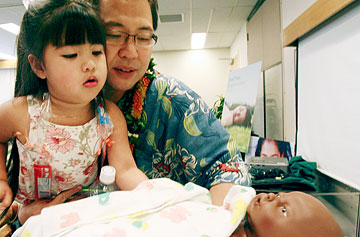 CINDY ELLEN RUSSELL / CRUSSELL@STARBULLETIN.COMDr. Mark Ogino and Chaiya Cauoette, 3, placed an infant medical training model on a bed at the Kaiser Moanalua Medical Center yesterday. Chaiya's life was saved by the extracorporeal membrane oxygenation (ECMO) device. CLICK FOR LARGE |
|
Kaiser built baby heart-and-lung device on the fly
An effort to save a newborn creates hope for others
A medical device pieced together to save a newborn's life at Kaiser Moanalua Medical Center has led to a $7.2 million partnership to expand the program to pediatric patients.
Kaiser Permanente neonatology director Dr. Mark Ogino spurred the development to save the life of T.J. Taeatafa, born with heart and lung problems in October 2003. Unable to send the baby to the mainland, Ogino asked Kaiser's Pete May to create an "extracorporeal membrane oxygenation" device for a newborn. It was a challenge for May, who operates the heart-and-lung machine during cardiac surgery on adults, but he did it in six hours.
The ECMO supports heart or lung function. Until May created one at the Moanalua center, Hawaii babies with lung failure had to be flown to the mainland for treatment.
Dr. Mark Ogino's voice broke with emotion as he thanked the family for "the privilege of taking care of their most precious possession" -- their newborn son.
"It's because of their faith in us that Hawaii keiki now have access to this lifesaving technology," said Ogino, Kaiser Permanente Hawaii neonatology director.
The technology is a heart-lung device crafted by Pete May in six hours on Oct. 22, 2003, to try to save the life of newborn T.J. Taeatafa at Kaiser Moanalua Medical Center.
Ogino told the dramatic story during a celebration yesterday of a $7.2 million federal grant to create a consortium of hospitals and the University of Hawaii medical school to expand the Kaiser program to pediatric patients.
Lively 3-year-old T.J. was there with his parents, Liiliola and Toetele, and three siblings.
"I'm going to get emotional and start crying," said the child's mother, thanking Ogino and the Kaiser team for the surgery and their support.
"We're very grateful, just happy he's here," she said. "That's the bottom line. We're very blessed."
Three other families whose lives were affected by the emergency construction of the device for T.J. also were present, as well as the medical team and others at Kaiser involved with the program. The device uses technology called extracorporeal (outside the body) membrane oxygenation, or ECMO, which drains blood, filters out carbon dioxide and puts in oxygen before the blood is returned to the body.
Kaiser's program and state-of-the-art ECMO will transfer July 1 to Kapiolani Medical Center.
Ogino is medical director of the newly formed Hanuola (Healing Breath) Consortium, and Dr. Larry Burgess at the UH medical school is principal investigator of a grant supporting "Hanuola: Pacific Pediatric Advanced Care Initiative."
"The kids we put on it are the sickest of the sick because we try all conventional medical managements first," Ogino said.
The machine couldn't save the life of Naomi and Keone Kamauoha's baby, Faith, born Sept. 12, 2005.
Yet the couple said they're grateful because they had time to be with their daughter when she was on the heart-lung machine .
"She taught us a lot of things," Naomi said. "She taught us to be parents." And Ogino and the nurses said they learned a lot of things from their baby to help other children, she said.
Aisha and Glad Cauoette said their daughter, Chaiya, was born March 10, 2004, at Kapiolani with heart-lung problems. She was sent to Kaiser for the ECMO machine "and she is definitely fine, healthy," Aisha said. "We're really lucky. We owe everything to Kaiser."
In the past, Hawaii newborns with heart and lung failure had to be flown by air ambulance to an ECMO center in California, which meant many delays overcoming problems of insurance, availability of a transport team and an airplane, Ogino said.
When T.J.'s lungs and heart began failing despite support from a breathing machine, Ogino said he tried to get an air ambulance, but chances of the baby surviving were very low had they waited for a transport team.
He told the parents it was possible they could try to create a heart-lung system for the baby. "I remember my conversation with the dad. He looked at me and said, 'Yes, go ahead.' I started to make some calls. It was an amazing day," Ogino said.
He said 17 Kaiser departments were involved with more than 30 people by the end of the day, from surgeons and nurses to telephone operators. He also called people across the country who were willing to help.
But first, he called Kaiser's May about making an ECMO. May is a profusionist at Kaiser who operates the heart-lung machine during cardiac surgery. "I never met the guy in my life," Ogino said, laughing. "He said, 'No,' and hung up on me."
Then he called back and said, "Let me look into it," Ogino said.
May, who usually works with adult patients, said, "There is such a big difference between neonatals and adults and frankly, I had never done it, so I said, 'Let's not do it.' "
But with Ogino "micromanaging 24 hours a day, we cobbled together something and made it work," he said.
"It is very rewarding," added May, who will help with 24-hour shifts at Kapiolani when a baby is on the machine.

